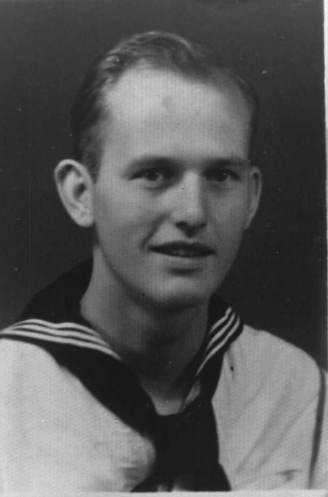
Oscar Rudie entered the U.S. Navy in January 1939. He was initially assigned to the USS Arizona. He transferred to the USS Marblehead, which was attached to the Asiatic fleet, in April 1940.
Machinist Mate 2nd Class Rudie was assigned to the aft engine room of the Marblehead. The Marblehead, along with the other U.S. and Dutch ships in the group, were headed for the Makassar Strait where a Japanese convoy was spotted. The goal of the force was to intercept the convoy.
A group of Japanese aircraft were sighted at about 10:00 a.m. They attacked the Marblehead and the other ships in the fleet. The Marblehead was hit by three bombs. One hit the fantail and destroyed the steering. The second bomb hit forward of the aft of the bridge superstructure starboard side. The third was a near miss on the port bow.
Mr. Rudie was on the main deck forward of the officer's ward room at the forward battle repair. The bomb that hit near the superstructure was the bomb that wounded him. Mr. Rudie remembers being airborne, then he was unconscious. When he came to he realized he had eye injuries. He got up and began making his way up to the bridge area. There was a lot of smoke. He could tell the sun was shining, but he was having trouble seeing anything else. An officer found him and took him aft to see if he could receive medical attention there. They discovered that the sick bay forward had been destroyed. They then went to the aft torpedo workshop where a make-shift medical station had been established.
Mr. Rudie is unsure exactly what injured his eye. It could have been that he suffered a blunt trauma when he was thrown by the bomb blast. Another possibility was paint chips. When a blast hits a ship the paint comes off the bulkhead and becomes shrapnel.
It took two days for the Marblehead to make port. The sailors that were burned were transferred to a hospital train. The rest of the injured, including Mr. Rudie, were placed on trucks and taken to a local hospital. They stayed overnight in the hospital, then the next day were transferred to a hospital in Djokjakarta. Mr. Rudie had, in his words, "A headache that wouldn't quit", and a right eye injury. He was treated at a clinic by a Chinese eye surgeon. They were unable to save his right eye, and it was surgically removed.
Later they were transported by train to Tjilitjap and to the dock to catch any ship available. The Dutch had set up cots for the wounded in a house. They spent a couple of days in the house awaiting transport. A Dutch freighter came in, and they took those that could walk to meet it to be evacuated. However, the captain refused to take them for concern about what would happen to them if the ship were sunk. They returned to the house to wait for the next opportunity.
A lieutenant tried again to evacuate the sailors. He took the names of those that could walk to see if he could find another ship for them. Two of those whose names he took, including Harold Hunter, could not walk, but they were able to fake the ability to walk so that they could get their names on the list. These men were then transported to the port where they were placed aboard the USS Sturgeon, M.V. Abbekerk (a Dutch freighter) and the USS Pecos, a Navy tanker. Mr. Rudie went aboard the Abbekerk. Two crew members gave up their rooms to Mr. Hunter and the other sailor that couldn't walk. The ships separately left port for Freemantle, Australia.
The next day a Japanese plane circled their ship. It was learned that the USS Langley was under attack at the time. It is believed that this plane was from the group attacking the Langley and was investigating the Abbekerk. This plane left them alone after making one ineffective run on the ship, and the Abbekerk made it to Freemantle.
They spent the night in Freemantle, then were transported by the Australian hospital ship Manunda to Adelaide. From there they took a hospital train to a hospital outside of Melbourne. Later Mr. Rudie was transported to New Zealand and then on to San Francisco.
Mr. Rudie was awarded the Purple Heart for the injuries he sustained on the Marblehead on February 4, 1942.
Mr. Rudie was discharged from the Navy on June 15, 1942. However, he didn't let his wounds interfere with his Navy career. Through the use of contacts he was able to get back into the Navy in November 1942. He was given limited duty as an instructor at a machinist school in San Diego and then on boiler watch in Los Angeles. He was discharged again from the Navy in September 1945, rated Machinist Mate 1st Class.
The above photo of Mr. Rudie was taken in July 1940 in Shanghai, China.
Mr. Rudie passed away on July 26, 2010 at the age of 90.
NOTE: The Webmaster would like to extend his appreciation to Mr. Rudie for all of his time and assistance in providing information for this Web site. It has been greatly appreciated!
Please Close This Window, Or go back to Crew